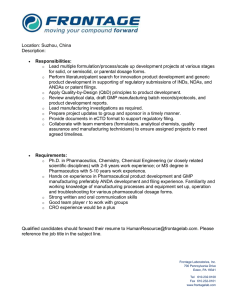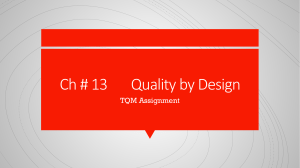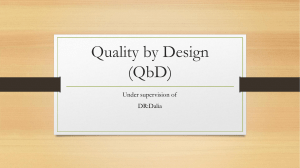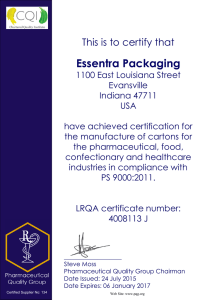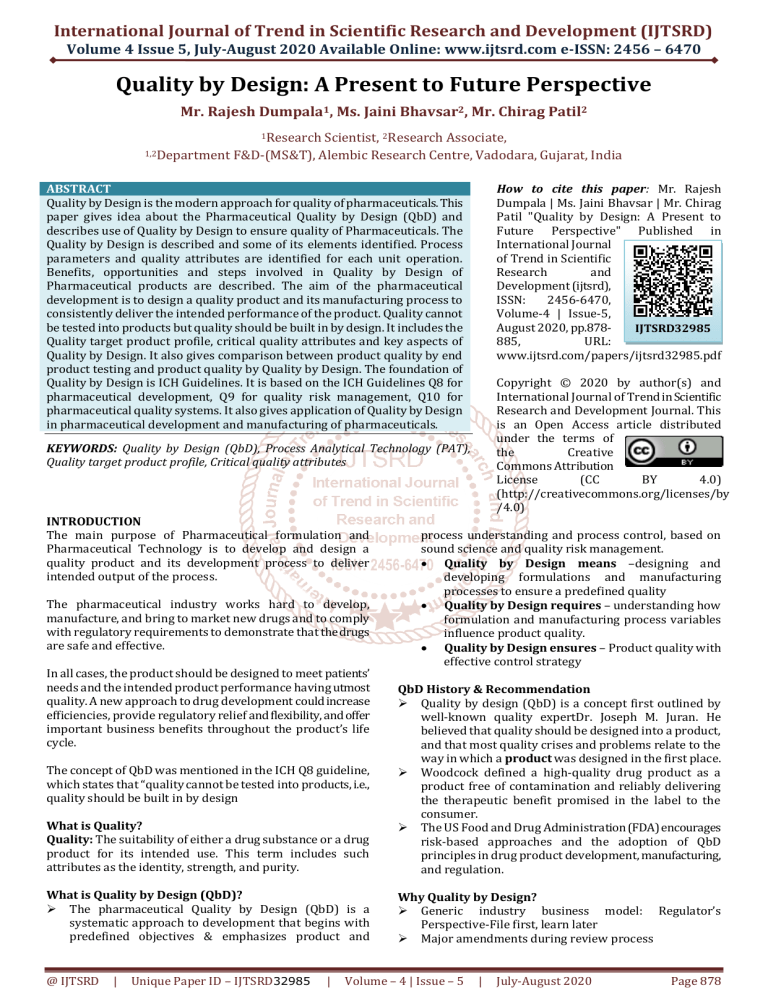
International Journal of Trend in Scientific Research and Development (IJTSRD) Volume 4 Issue 5, July-August 2020 Available Online: www.ijtsrd.com e-ISSN: 2456 – 6470 Quality by Design: A Present to Future Perspective Mr. Rajesh Dumpala1, Ms. Jaini Bhavsar2, Mr. Chirag Patil2 1Research Scientist, 2Research Associate, 1,2Department F&D-(MS&T), Alembic Research Centre, Vadodara, Gujarat, India ABSTRACT Quality by Design is the modern approach for quality of pharmaceuticals. This paper gives idea about the Pharmaceutical Quality by Design (QbD) and describes use of Quality by Design to ensure quality of Pharmaceuticals. The Quality by Design is described and some of its elements identified. Process parameters and quality attributes are identified for each unit operation. Benefits, opportunities and steps involved in Quality by Design of Pharmaceutical products are described. The aim of the pharmaceutical development is to design a quality product and its manufacturing process to consistently deliver the intended performance of the product. Quality cannot be tested into products but quality should be built in by design. It includes the Quality target product profile, critical quality attributes and key aspects of Quality by Design. It also gives comparison between product quality by end product testing and product quality by Quality by Design. The foundation of Quality by Design is ICH Guidelines. It is based on the ICH Guidelines Q8 for pharmaceutical development, Q9 for quality risk management, Q10 for pharmaceutical quality systems. It also gives application of Quality by Design in pharmaceutical development and manufacturing of pharmaceuticals. How to cite this paper: Mr. Rajesh Dumpala | Ms. Jaini Bhavsar | Mr. Chirag Patil "Quality by Design: A Present to Future Perspective" Published in International Journal of Trend in Scientific Research and Development (ijtsrd), ISSN: 2456-6470, Volume-4 | Issue-5, August 2020, pp.878IJTSRD32985 885, URL: www.ijtsrd.com/papers/ijtsrd32985.pdf Copyright © 2020 by author(s) and International Journal of Trend in Scientific Research and Development Journal. This is an Open Access article distributed under the terms of the Creative Commons Attribution License (CC BY 4.0) (http://creativecommons.org/licenses/by /4.0) KEYWORDS: Quality by Design (QbD), Process Analytical Technology (PAT), Quality target product profile, Critical quality attributes INTRODUCTION The main purpose of Pharmaceutical formulation and Pharmaceutical Technology is to develop and design a quality product and its development process to deliver intended output of the process. The pharmaceutical industry works hard to develop, manufacture, and bring to market new drugs and to comply with regulatory requirements to demonstrate that the drugs are safe and effective. In all cases, the product should be designed to meet patients’ needs and the intended product performance having utmost quality. A new approach to drug development could increase efficiencies, provide regulatory relief and flexibility, and offer important business benefits throughout the product’s life cycle. process understanding and process control, based on sound science and quality risk management. Quality by Design means –designing and developing formulations and manufacturing processes to ensure a predefined quality Quality by Design requires – understanding how formulation and manufacturing process variables influence product quality. Quality by Design ensures – Product quality with effective control strategy What is Quality? Quality: The suitability of either a drug substance or a drug product for its intended use. This term includes such attributes as the identity, strength, and purity. QbD History & Recommendation Quality by design (QbD) is a concept first outlined by well-known quality expertDr. Joseph M. Juran. He believed that quality should be designed into a product, and that most quality crises and problems relate to the way in which a product was designed in the first place. Woodcock defined a high-quality drug product as a product free of contamination and reliably delivering the therapeutic benefit promised in the label to the consumer. The US Food and Drug Administration (FDA) encourages risk-based approaches and the adoption of QbD principles in drug product development, manufacturing, and regulation. What is Quality by Design (QbD)? The pharmaceutical Quality by Design (QbD) is a systematic approach to development that begins with predefined objectives & emphasizes product and Why Quality by Design? Generic industry business model: Regulator’s Perspective-File first, learn later Major amendments during review process The concept of QbD was mentioned in the ICH Q8 guideline, which states that “quality cannot be tested into products, i.e., quality should be built in by design @ IJTSRD | Unique Paper ID – IJTSRD32985 | Volume – 4 | Issue – 5 | July-August 2020 Page 878 International Journal of Trend in Scientific Research and Development (IJTSRD) @ www.ijtsrd.com eISSN: 2456-6470 Exhibit batch stability failure, formulation revision Longer time for generic product approval Approved product may not be marketed Post approval changes – prior approval supplements Table: I Current vs. QbD Approach to Pharmaceutical Development Current Approach QbD Approach Quality built into product & process by design, Quality assured by testing and inspection based on scientific understanding Data intensive submission – disjointed Knowledge rich submission – showing product information without “big picture” knowledge & process understanding Specifications based on product performance Specifications based on batch history requirements Flexible process within design space, allowing “Frozen process,” discouraging changes continuous improvement Focus on reproducibility – often avoiding Focus on robustness – understanding and or ignoring variation controlling variation The New Quality Paradigm includes the Risk based concepts and Principles. It includes ICH guidelines Q8, Q9, Q10 and Q11. Fig:-I Quality Paradigm includes the Risk based concepts and Principles Wherein, Q8: Pharmaceutical Development Past: Data Transfer / Variable Output Present: Knowledge transfer / Science based / Consistent Output Q9: Quality Risk Management Past: Used, however poor defined Present: opportunity to use structured process thinking Q10: Pharmaceutical Quality Systems Past: GMP Checklist Future: Quality systems across product life cycle. Key Elements of Quality by Design: Fig:-IIKey Elements of Quality by Design @ IJTSRD | Unique Paper ID – IJTSRD32985 | Volume – 4 | Issue – 5 | July-August 2020 Page 879 International Journal of Trend in Scientific Research and Development (IJTSRD) @ www.ijtsrd.com eISSN: 2456-6470 Fig:-III Quality control diagram using QbD Quality Target Product Profile Table: II Quality By Design Define QTPP (Quality Target Product Profile) On the basis of THERAPEUTIC EQUIVALENCE for Generic Drug Product= PHARMACEUTICAL EQUIVALENCE (same dosage form, route of administration, strength & same quality)+ BIO-EQUIVALENCE (same pharmacokinetics in terms of Cmax, AUC to reference product) Critical Quality Attributes Determine CQAs (Critical Quality Attributes) Considering QUALITY [Assay, Uniformity of Dosage units,], SAFETY [Impurities (Related substances), Residual Solvents, Microbiological limits], EFFICACY [Dissolution & Absorption] & MULTIDISCIPLINARY [Patient Acceptance & Compliance] Risk Assessment Of Cmas & Cpps Quality Risk Assessment of CMAs & CPPs by 1.RISK IDENTIFICATION: by Ishikawa Fishbone 2.RISK ANALYSIS by Relative Risk based Matrix Analysis 3.RISK EVALUATION by Failure Mode Effective Analysis Design Of Experiments DoE & Generation of Design Space For SCREENING & OPTIMIZATION of CMAs & CPPs with respect to CQAs by superimposing contour plot to generate OVERLAY PLOT (Proven acceptable Ranges & Edges of failure) based upon desired ranges of Responses Process Analytical Technology Development of PAT System For continuous automatic analyzing & controlling critical processing through timely measurements of CMA & CPAS by INLINE ANALYZERS WITH AUTO SENSORS with the ultimate goal of consistently ensuring finished product quality with respect to desired CQAs Control Strategy Implementation of Control Strategy For CONTROLS OF CMAs, CPPs within Specifications, by Real Time Release Testing, Online Monitoring System * Inline PAT Analyzers [based upon previous results on development, Scale Up. Exhibit/ Validation batches] Continual Improvement Continual Improvement Based upon CONTINUAL RISK REVIEW & RISK COMMUNICATION BETWEEN PLANT, QA, QC, RA, R&D, AR&D during routine commercial manufacturing experience @ IJTSRD | Unique Paper ID – IJTSRD32985 | Volume – 4 | Issue – 5 | July-August 2020 Page 880 International Journal of Trend in Scientific Research and Development (IJTSRD) @ www.ijtsrd.com eISSN: 2456-6470 What is QTPP? A Prospective summary of the quality characteristics of a drug product that ideally will be achieved to ensure desired quality, taking into account safety and efficacy of a drug product. QTPP is widely used in development planning, clinical and commercial decision making, regulatory agency interactions, and risk management. The QTPP guides formulation scientists to establish formulation strategies and keep the formulation effort focused and efficient Fig:-IV Quality Target Product Profile QTPP Component Dosage Form & Strength Appearance & Identity Pharmacokinetics Dissolution, Content Uniformity Impurities & Residual Solvents CQAS Assay (Efficacy) Impurities (Safety) C.U (Efficacy) Dissolution What factors affect drug product CQAs? Properties of Input Materials- Identify Critical Material Attributes (CMAs) Properties of in-process materials- CQAs of one step become CMAs for a downstream unit operation Manufacturing process parameters- Identify Critical Process Parameters (CPPs) “A process parameter, e.g. temp, time, speed, when variable it can affect the CQA of a product or process” Critical process parameters (CPP) are process inputs that have a direct and significant influence on critical quality attributes when they are varied within regular operation range. Fig:-V factors affect drug product CQAs QUALITY RISK MANAGEMENT Quality: Degree to which a set of inherent properties of a product, system or process fulfills requirements. Risk: defined as the combination of the probability of occurrence of harm and the severity of that harm. Management: Systematic process for the assessment, control, communication and review of risks to the quality of the drug (medicinal) product across the product lifecycle. Risk Identification: The risk assessment team assigned to this initiative first prepared a list of all operations and associated supporting systems that had potential impact on product quality. Risk Analysis and Evaluation: The Risk Analysis stage of the QRM process estimates the potential harm(s) associated with each potential risk. The analysis may be qualitative or quantitative in nature, or a combination of the two. @ IJTSRD | Unique Paper ID – IJTSRD32985 | Volume – 4 | Issue – 5 | July-August 2020 Page 881 International Journal of Trend in Scientific Research and Development (IJTSRD) @ www.ijtsrd.com eISSN: 2456-6470 Fig:-VIQuality Risk Management Fig:-VII Ishiwaka Diagram Failure Mode and Effects Analysis (FMEA) Identify potential failure modes for a product or process, To assess the risk associated with those failure modes, To rank the issues in terms of importance and To identify and carry out corrective actions to address the most serious concerns. The risk score or Risk Product Number (RPN) was determined by multiplying the scores for probability, severity and detectability: RPN = Probability Score x Severity Score x Detectability Score The ranking definitions for Probability, Severity, and Detectability were developed prior to commencing any actual assessment. After the risk areas were identified, subject matter experts worked to evaluate each risk area and list corresponding failure modes and associated failure effects for each risk area. The final output was published for risk prioritization. Scoring Scheme for Probability, Severity, and Ability to Detect: A RPN of < 40 was considered a low risk; a RPN of 40 – 99 was identified as an intermediate risk; and a RPN of 100 or greater was defined as a high risk. It is based on Probability, Severity and Detectability. Design Space (ICH Q8) Definition: The multidimensional combination and interaction of input variables (e.g., material attributes) and process parameters that have been demonstrated to provide assurance of quality Working within the design space is not considered as a change. Movement out of the design space is considered to be a change and would normally initiate a regulatory post-approval change process. Design space is proposed by the applicant and is subject to regulatory assessment and approval QbD & Statistics Statistical analysis has multiple roles in the Quality by Design approach Statistically designed experiments (DOEs) Model building & evaluation @ IJTSRD | Unique Paper ID – IJTSRD32985 | Volume – 4 | Issue – 5 | July-August 2020 Page 882 International Journal of Trend in Scientific Research and Development (IJTSRD) @ www.ijtsrd.com eISSN: 2456-6470 Statistical process control Sampling plans DESIGN OF EXPERIMENTS A structured organized method for determining the relationship between factors affecting a process and theoutput of that process Fig:-VIIIDesign Of Experiments PROCESS ANALYTICAL TECHNOLOGY (PAT) Process analytical technology (PAT) can be defined as “a system for designing, analyzing, and controlling manufacturing through timely measurements (i.e., during processing) of critical quality and performance attributes of raw and in-process materials and processes, with the goal of ensuring final product quality” Fig:-IX Process Analytical Technology (PAT) CONTOL STRATEGY:“A planned set of controls, derived from current product and process understanding that ensures process performance and product quality…..” ICH Q8 (R2) & Q10 Control Strategy includes following elements (but not limited to): Input material attributes (e.g. drug substance, excipients, container closure) Equipment operating conditions (process parameters) @ IJTSRD | Unique Paper ID – IJTSRD32985 | Volume – 4 | Issue – 5 | July-August 2020 Page 883 International Journal of Trend in Scientific Research and Development (IJTSRD) @ www.ijtsrd.com eISSN: 2456-6470 In-process controls Finished product specifications Controls for each unit operations Methods and frequency of monitoring and control. Fig:-X Contol Strategy BENEFITS OF QbD QbD is good Science and Business Reduces number of manufacturing supplements required for post market changes –rely on process and risk understanding and risk mitigation Eliminate batch failures Allows for implementation of new technology to improve manufacturing without regulatory scrutiny Minimize deviations and costly investigations Avoid regulatory compliance problems Organizational learning is an investment in the Future Allows for possible reduction in overall costs of manufacturing –less waste Better development decisions & Empowerment of technical staff Ensures less hassle during review –reduced deficiencies –quicker approvals Improves interaction with FDA –deal on a science level instead of on a process level Benefits of implementing QbD for FDA Enhances scientific foundation for review Provides for better coordination across review, compliance & inspection Allows for continuous improvements in products and manufacturing process. Provides for more flexibility in decision making References: [1] U. S. Food and Drug Administration. Quality by Design for ANDAs: An Example for Immediate-Release Dosage Forms. April 2012. Ensures decisions made on science & not on empirical information [2] 21 CFR Part 211 Current Good Manufacturing Practice for Finished Pharmaceuticals, Subpart C. Involves various disciplines in decision making [3] U. S. Food and Drug Administration. Guidance for Industry. PAT – A Framework for Innovative Pharmaceutical Development, Manufacturing and Quality Assurance. September 2004. Improves information in regulatory submissions Improves quality of review (establishing a QMS for CMC) Uses resources to address higher risks Benefits to Industry Ensures better design of products with less problems in manufacturing @ IJTSRD | Unique Paper ID – IJTSRD32985 | [4] Articles by SHIVANG CHAUDHARY, Formulation Scientist (Pharma-QbD Associate) M. S. Pharm (Pharmaceutics)- NIPER P.G.D (Patents Law)- NALSAR Volume – 4 | Issue – 5 | July-August 2020 Page 884 International Journal of Trend in Scientific Research and Development (IJTSRD) @ www.ijtsrd.com eISSN: 2456-6470 [5] Gillian Doherty and Jane Beach Martha Friendlyn “Quality by design: What do we know about quality in early learning and child care, and what do we think?” A literature review pp. 1-32. [6] ICH Q8 (R2) (2009) Pharmaceutical Development. [7] Lawrence X. Yu (2006) Director of science. “Implementation of Quality by Design”, Question based review. [8] Anat IB (2013) QbD Strategy Leader, “Bud implementation in Generic Industry: Overview and Case-Study” IFPAC JAN. [9] Avellant J (2008) “Why Quality by Design?” Expert Brefings pp. 1-12. @ IJTSRD | Unique Paper ID – IJTSRD32985 | [10] Roy S (2012) “Quality by Design-Holistic concept of concept of building quality in pharmaceuticals”. Int J Pham Biomed Re 3: 100-108. [11] Blackburn TD (2011) “An Introduction to QbD (Quality by Design) and Implications for Technical Professionals”, ISPE CASA Annual Technology Show. [12] Nishendu P et al. (2012) “A complete review of Quality by Design”. Int J Pharm Sci Rev Res 17:20-28. [13] Lawrence X. Yu (2008) “Quality by Design: Concept for ANDA’s” .AAPS J 10: 268-276. [14] ICH Q9: Quality Risk Management - an update 14 May 2014. Volume – 4 | Issue – 5 | July-August 2020 Page 885
